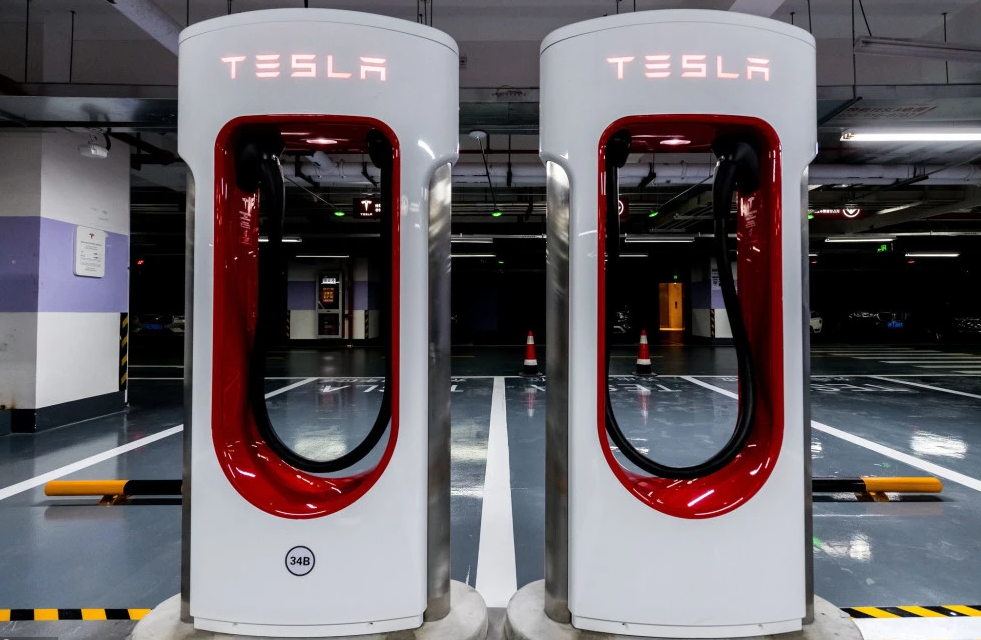- Home
- News
- What are the Characteristics of the Tesla Photovoltaic + Energy Storage + Charging Integrated Super Charging Station?
What are the Characteristics of the Tesla Photovoltaic + Energy Storage + Charging Integrated Super Charging Station?
Recently, Tesla’s Shanghai photovoltaic + energy storage + charging integrated super charging station inauguration and unveiling ceremony was grandly held in the Wisdom Bay Science and Technology Park in Baoshan District, Shanghai, which will bring considerable orders to Tesla’s supply system in the Chinese market, such as automotive electronics, power modules, magnetic materials, magnetic components and other fields.
A month ago, Tesla has opened China’s first Tesla photovoltaic + energy storage + charging integrated super charging station in Lhasa.
Tesla photovoltaic + energy storage + charging integrated super charging station uses solar photovoltaic panels to generate electricity, converts sunlight into electrical energy, stores energy through Powerwall energy storage equipment, and then powers electric cars through V3 super charging piles and destination charging piles Charging use. When the load and optical storage configuration are balanced, the energy self-sufficiency of electric vehicles is achieved.
From the perspective of Tesla’s layout, it is clear that the company is not only focusing on the pure electric vehicle market, but the entire pan-pure electric vehicle business circle, making photovoltaics, energy storage, and charging piles a solidly connected ecosystem.
In addition, Tesla’s photovoltaic + energy storage + charging integrated super charging station has a feature that is clearly different from the domestic layout-Tesla’s super charging station is not only oriented to the B-side heavy capital market and the G-side policy market, but also is sold to a single household user, abandoning the past marketing model of charging piles, photovoltaics, and energy storage only on the B-end.
Judging from the existing products of Tesla, new energy vehicles, Powerwall batteries, and solar roof systems are all products for C-end users. Users can build what they need, and at the same time, they always focus on new energy. Replace the “product-oriented” model of car companies in the past with “user-oriented” thinking.
Tesla has made pure electric vehicles into a systematic business model, which is no longer a single product sales. It not only solves the charging problems of car owners, but also drives the promotion and sales of more surrounding high-priced products, and further deepens consumers’ impression of Tesla’s brand.
Powerwall is mainly aimed at home users, with built-in battery capacity of 7 ~ 13.5kwh. The commercial version of “Powerwall” is called PowerPack, with a built-in 100kwh battery, which is mainly used in public places.
It is reported that Tesla’s integrated photovoltaic + energy storage + charging super charging station facility has already been commercialized in many areas outside of mainland China. As of the end of May this year, Tesla has installed 200,000 such facilities in the three markets of the United States, Australia and Germany.
In 2020, the total installed capacity of Tesla’s energy storage battery is 3.02GWh, an increase of 83% year-on-year. A total of 100,000 sets of Powerwall family battery packs have been installed. Encouraged and stimulated by policies of various countries, it is estimated that the installed capacity of the global household energy storage market will exceed 140GW by 2023.
Strong demand also gave Tesla the confidence to increase prices. Before October last year, the price of Powerwall in the US market was increased from US$6,500 to US$7,000, and in January this year, it was raised to US$7,500 again. The integrated super-charging model of photovoltaic + energy storage + charging adopted by Tesla will surely bring a guiding effect to many domestic electric vehicle companies. Once Tesla’s business model of super charging stations is successfully realized in China, it will also bring considerable orders to Tesla’s supply system in the Chinese market.
Most domestic magnetic materials and magnetic component companies are Tesla’s second and third-tier suppliers. After the dual carbon plan is proposed, the field of photovoltaic + energy storage + charging will achieve rapid development.
It is understood that Tiantong’s magnetic materials have been applied to Tesla’s Shanghai super charging pile project products through magnetic component products. Tesla’s Shanghai super charging pile factory invested about 42 million yuan, and the initial planned annual production capacity was 10,000 super charging piles, and mainly V3 super charging piles. On February 3 this year, Tesla’s Shanghai Super Charging Pile Factory was officially completed and put into production, and the V3 Super Charging Pile was officially off the assembly line.
